Tuesday, July 24, 2007
Wednesday, July 18, 2007
Toxitur in Lago Agrio
After 30 minutes in the back of a police truck escort (yes, my second time in South America) we managed to find the place, which was of course closed. We did manage to locate some phone numbers, however, and got in touch with president of the Front, who was at the time in the smallish jungle town Coca, a few hours south of Lago Agrio. He agreed to meet us the following morning.
I was thrilled. Saturday morning, I began to realize the influences that oil had on this place. My breakfast menu had three options: Desayuno Regular, Americano, or Petrolero (the first two are very common in South America). I of course got the Petrolero, which of course came with meat. The name of a hotel across the street was "Hotel Oro Negro." Many working-age people on the street wore jackets or shirts branded with either Texaco or PetroEcuador. The city also clearly had a delinquency problem, was broken down economically, and was recently in the papers because of a public demonstration. I knew I was in for some drama.
It turns out that the person who would meet is us is Jose Fajardo, the president of the Amazon Defense Coalition (interchangeable with Frente de la Defensa de la Amazonia). The organization was created in 1993 and has served as the central front for a legal case against the Chevron-Texaco corporation. In 2003, Ecuadorian plaintiffs (led by Jose´s brother, Pablo) filed a class action lawsuit against Texaco, representing representing 30,000 indigenous Ecuadorians.
The kicker of the case is that it is being tried in Ecuador, a win for the "good guys" and the first time a case against a transnational corporation has been tried outside of its home country. The trial is now in the phase of damages assessment where a group of expects will place a dollar value on cleanup efforts. The figure is looking like $6 billion that Texaco would have to pay for basic environmental remediation. The damages assessment is expected to be turned over to the court this fall, with a final decision to come several months later. After that, the plaintiffs expect YEARS of appeals from Texaco before the damages award is actually dispersed.

So it goes. What seems to be making people especially mad is that the Texaco legal defense team seems to be using "stalling" tactics to delay judgment of the case. Who knows why they are doing it, but it has been reason enough for the Front to organize a manifestation in Lago Agrio recently to get some attention from the public.
 A couple thousand people turned out to form some human chains around the first oil derrick that Texaco put up in the 70´s. The resulting images made it to the recent Live Earth show in New York, and the lead lawyer in the case (Jose´s brother) did some shoulder rubbing with Sting and Weird Al Gore.
A couple thousand people turned out to form some human chains around the first oil derrick that Texaco put up in the 70´s. The resulting images made it to the recent Live Earth show in New York, and the lead lawyer in the case (Jose´s brother) did some shoulder rubbing with Sting and Weird Al Gore.
Pretty good story, right? So Jose gave us some great background on the communities affected and the various means by which the Front tries to help them out. He also offered to show us some sights, in what he called the ToxiTur. We hired a driver to take us out to the small town Shushufindi, one of the nearby areas affected by the drilling.
He gave us the rockstar tour. Or rather, Presidential. Among the recent tour participants have been Sting´s wife, Darryl Hannah, and the President of Ecuador, Rafael Correa.
I should know what these things are called but I don´t (note I call the petroleum "gas" in the clip because I am confused. Must be the fumes). The point is that they burn excess petroleum. The main issue here is that Texaco initially built them LOW (just a few feet off the ground). Occasionally, large pools of oil would catch on fire producing LARGE smoke clouds. The resultant (carcinogenic) particulate matter would wind up in the rain water, which indiginous people have a habit of collecting from their rooftops when fresh drinking water is scarce...
One of the 800 reserve pits that Texaco left behind. These pools are normally formed during the drilling process to dispose of rock cuttings and drilling mud. They are supposed to be lined with plastic to protect the environment, and are supposed to be sealed off after drilling is complete. This is an example of neglect on both accounts. Some reserve pit sites Texaco did cover over, but did not adequately contain the surfaced oil. It migrated and resurfaced, sometimes in the backyards of families.
Looking like a million bucks.
An example of backyard migration. This man has multiple forms of cancer (skin and ocular) and has been living on his property for over 20 years. He showed us where petrol-mud has sprung up (a 6-foot deep swamp slowly pooled up in his backyard) and also yanked on his eyelid for us to show us where he was lacking nerves, I think. The fumes are apparently much less tolerable in hotter weather (it was a tepid day in the jungle).
An artsy picture of one of the old "highways" that Texaco put up when they were building a drilling infrastructure. Rather than asphalt based, dirt paths were simply mixed with petroleum to reduce dust as construction equipment moved in and out of the drill sites. What was not foreseen (one would hope) is that locals would use these paths daily for their own business. On hot days, the petroleum would heat up and emit carcinogenic gases. Cervical cancer rates of young girls in this area skyrocketed during this period -- the "good guy" explanation being that they walked these paths daily to schools, work, etc, without knowing that they were exposing their reproductive organs to cancer causing agents. Nasty stuff.
The ubiquitous pipelines that line the highways.
Quite a day it was. If anyone would like further information, just let me know.
Monday, July 16, 2007
The Orient
- Eating ¨lemon ants¨ that live inside certrain tree branches and secrete a liquid that does taste just like lemons.
- Lots and lots of bugs, spiders, exotic birds
- Lots of monkeys too. and some freshwater ¨pink¨ dolphins and sloths and night snakes
- Visiting an indigenous community (the Siona) and contemplating how they do their business (agriculture, trade, and suspect intra-family procreation)
- Catching a monster cicada in a whiskey glass and letting it loose in a sleeping cabana-mate´s mosquito net (not really...we were too nice).
- Motorboatin´
- Sunset in a ¨flooded forest¨lake
Great trip. And every great trip deserves a great segway...
The entry point to this portion of the Ecuadorian jungle is a 34,000 person city known as Lago Agrio, which is generally regarded as one of the more dismal and dodgy cities in the country. It´s proper name is Nueva Loja, but on most maps it´s labeled as Lago Agrio. Translated to English it´s Sour Lake, the name of the small town in Texas where Texaco is said to have been founded. This town in Ecuador was essentially founded and developed as an oil town in the 1970´s, when Texaco explored for and extracted oil from the Ecuadorian rainforest until 1992 when its contract with the state expired.
This bit of trivia first piqued my interest a few weeks ago. On top of that, the front page of the best'regarded Ecuarodian newspaper (El Comercio) was graced with a picture of protests in Lago Agrio about 10 days ago. A few thousand people organized themselves around the very first oil drill that was erected by Texaco in Ecuador and made some human-chain political protest messages that were photographed aerially and broadcast during the recent Live Earth concert in New York. Upon hearing this, I was seriously interested in what was going on in this town. So, after my jungle trip, I made a stopover in this gem of a town. What would transpire has to-date been my most memorable exprience of this trip.
From what I had gathered beforehand, Texaco pumped a LOT of oil from the Ecuadorian jungle, set up an entire infrastructure of pipelines to ship it to the coast, and acted a little less than responsibly while (contestably) adhering to weak Ecuadorian laws until their contract expried, and made a bunch of people mad for various reasons. The Texaco story also interested another traveller from the jungle trip, a German named Soeren (where is the o with the dots over it key??) who joined me on the adventure to find out more. More to come, but here´s a glimpse of how I spent my weekend:
The coast
A little after July 4th, I hopped on an overnight bus from Quito for a weekend on the southern Pacific coast of Ecuador, specifically to a small fishing town called Puerto Lopez. Besides being a pretty good place to soak up the cultural differences between Ecuadorians from the mountains and the coast, Puerto Lopez is a great place to witness the annual migration of humpback whales from the south (like Antarctica south). The whales come to these waters to mate and to give birth between June and September, and there are lots of them.
Additionally, Pûerto Lopez is very close to Isla De La Plata, a small Ecuadorian island that is affectionally dubbed the ¨poor man´s Galapagos.¨ The name is very fitting. I hired a boat to both tour some supposedly mating-whale-infested waters and to get out to the island for some exploring. They were right about the whales -- there were lots of them, and they were big...like big grey schoolbuses that would occasionally surface right near the boat for a breath or to jump out of the water.
As far as Isla de la Plata, there was lots of wildlife that was not afraid of humans, just like you´d find in the Galapagos. And it was about $980 cheaper than a trip to the Galapagos (which I refuse to visit without scuba diving certifications, a significant other to share it with, and/or an AARP discount card). Of course it couldn´t compare to the real thing (Galapagos), but I got up close and personal to lots of creatures like the albatross, sea lions, frigate birds and my favorite, blue footed boobies.
I´m lacking the pictures department for the time being - my real camera was in the shop and I´ve been lazy about developing the disposable camera pictures I took...all in good time.
Additionally, Pûerto Lopez is very close to Isla De La Plata, a small Ecuadorian island that is affectionally dubbed the ¨poor man´s Galapagos.¨ The name is very fitting. I hired a boat to both tour some supposedly mating-whale-infested waters and to get out to the island for some exploring. They were right about the whales -- there were lots of them, and they were big...like big grey schoolbuses that would occasionally surface right near the boat for a breath or to jump out of the water.
As far as Isla de la Plata, there was lots of wildlife that was not afraid of humans, just like you´d find in the Galapagos. And it was about $980 cheaper than a trip to the Galapagos (which I refuse to visit without scuba diving certifications, a significant other to share it with, and/or an AARP discount card). Of course it couldn´t compare to the real thing (Galapagos), but I got up close and personal to lots of creatures like the albatross, sea lions, frigate birds and my favorite, blue footed boobies.
I´m lacking the pictures department for the time being - my real camera was in the shop and I´ve been lazy about developing the disposable camera pictures I took...all in good time.
The Coast and the Jungle
Wow, 14 days since my last post, which has really been because I have been that busy running around and catching up on lost time. I will be making a big post tonight to try to document what I have been up to, but in reverse chronological order, I took a trip to the Pacific coast of Ecuador, came back to Quito, collected my passport and credit card (hallelujah), took an overnight trip to the orient (west of the Andes) of Ecuador for a 4 day trip to the Jungle, then went to an oil town in the Orient. More to come!
Monday, July 2, 2007
Tumult
The last week has been very chaotic, and I didn´t want to make a post until I had a story to tell. First, the bad, bad news. Last Thursday night I was sitting in an internet cafe much like the one I´m in right now. I looked down at my feet a couple of minutes into my internet session and noticed that my backpack was no longer leaning against my leg. I was robbed. I pushed my chair back, threw a fit, stalked the streets, and asked the guy who worked at the cafe to call the police. Their investigative work consisted of driving me around the block 2 times in their Honda CRV and dropping me off at the police station to create a ¨denuncia.¨ I walked away with a piece of paper confirming that someone had stolen my backpack (the guy who worked at the cafe said he thought it was a Peruvian woman with red hair who was in her 30s). It also listed the possessions that were missing, as typed up by the rudest secretary I have ever met (get ready to cringe):
VARIOS LIBROS EN ESPAÑOL
LIBROS DE TURISMO DE ECUADOR
MI PASAPORTE ORIGINAL DE LOS ESTADOS UNIDOS
DOS TARJETAS DE CREDITO UNA VISA Y UNA AMERICAN EXPRESS
DINERO EFECTIVO 250 DOLARES
VARIOS CUADERNOS CON APUNTOS PERSONALES
Y OTROS BIENES PERSONALES
A seriously bad night. I was left with 11 dollars to my name and zero personal identification (in my brilliance that day I kept my passport in the same place where I kept multiple laminated copies of my passport and credit cards....my backpack). The only shining light was that immediately beforehand I had taken my camera to a repair shop, so it survived the theft. I cancelled my credit cards, got intimate with the U.S. Embassy in Quito, had some ¨glamour head shots¨ taken at a photography place for my passport picture, and wrestled with the powers that be at Western Union to permit a transfer of cash from the U.S. with only a photocopy of an application for a new passport and the accompanying police report to call personal identification. My new passport should be here by next Monday.
The moral of the story is that I´m an idiot. Quito is pretty safe but petty theivery is rampant all over. I was lazy and careless, and absolutely should have at least had the strap of the backpack wrapped around my leg (the strap of the new $7 replacement bag I bought is wrapped around my leg right now. Two of its zippers already broke, so there´s no way I´m going to look like a rich tourist sporting it). Additionally, I had stuffed my money belt (which is supposed to go around your waist under your clothes) in my backpack, defeating the purpose of its design. I kind of deserved it.
So that would have been my weekend, and I would have wallowed around Quito thinking about the stuff I lost (which included the phone number of a Quiteña girl I´ve gotten to know down here - the only way I had to contact her). But no. Friday night I went out to a popular gringo bar called Bungalo 6, getting home around 3 AM. Saturday morning I woke up at 7:30 AM, totally disoriented until I remembered why I had set my alarm the night before. Friday afternoon I learned that Saturday night would bring a full moon to Ecuador. Prime time for a midnight stroll!
To backtrack a bit, last weekend I made an ill-fated voyage to Cotopaxi National Park to scale the South face of Cotopaxi, a snow-capped volcano (height: 5,897 meters aka. 19,342 feet). During my 3-day, 2-night stay the weather changed from bad to awful, and during the afternoon that we (me, an indigenous guide and a 40-something semi-professional swiss alpinist woman) hiked from our refuge (4200 meters) to a set of permanent tents (4900 meters) designed as a rest stop before the climb to the summit (5897 meters), the mountain gods were not having it. The wind and snow made visibility almost zero, and the soft snow on the ground made for waist-deep hiking and possible avalanches. We opted out. I was a little bitter.
So back to the full moon. Saturday morning I woke up a stupor and decided on the spot that if a travel agency would take me in my condition (and hadn´t left for the mountain yet), it was a sign that a repeat effort was meant to be, even if it blew a big portion of the precious cash that was Western Unioned from the States. I checked out of my hostal and galloped to the gringo district of Quito with all my personal belongings (sans passport). I spotted people putting snow gear into a truck in front of a travel agency, and sure enough they were heading for Cotopaxi with 2 Australian tourists. I talked the jefe (boss) down to a pretty deep discount on the normal excursion price, and before I knew it I was on my way back to Cotopaxi, this time to attempt the much more heavily travelled north face with the Aussies and a guide.
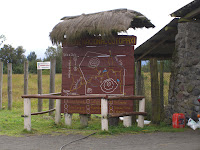 We got to the 4800 meter refuge at about 2 PM, had lunch, had dinner at 5:30 PM, and were ushered upstairs to the sleeping quarters shortly thereafter. The ¨sleeping quarters¨ was really an attic with about 35 iron cots stacked up 3 levels. I grabbed a cot at 6:30, jumped in my sleeping bag and fell right asleep (thank you earplugs) until midnight, when everyone got back up for breakfast. Yes, midnight.
We got to the 4800 meter refuge at about 2 PM, had lunch, had dinner at 5:30 PM, and were ushered upstairs to the sleeping quarters shortly thereafter. The ¨sleeping quarters¨ was really an attic with about 35 iron cots stacked up 3 levels. I grabbed a cot at 6:30, jumped in my sleeping bag and fell right asleep (thank you earplugs) until midnight, when everyone got back up for breakfast. Yes, midnight.
At 1:00 I was fully outfitted in ice climbing gear (ice axe, rope and crampons) and we were off to climb Cotopaxi. That night, I am told some 40 people attempted the climb to the top. Me, the Aussies and our guide were among the 10 that made it to the top. It was not easy.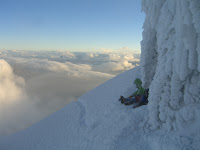 The views during the night were incredible when the sky was clear, and the big full moon made it so we didn´t have to use flashlights for much of the time. We were well above the clouds when dawn broke, and at one point the sun was rising on one side of the mountain while the moon was illuminated on the other.
The views during the night were incredible when the sky was clear, and the big full moon made it so we didn´t have to use flashlights for much of the time. We were well above the clouds when dawn broke, and at one point the sun was rising on one side of the mountain while the moon was illuminated on the other. 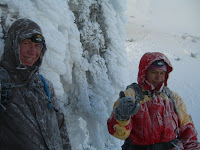
As this was my first climbing experience the only thing I can compare it to is looking out the window of an airplane. To complete the imagery, though, the airplane´s fuselage would be made of incredible ice formations and it would also be cruising with the windows rolled down -- it was that windy.


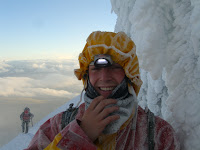
We reached the summit at 8 PM, a dangerously late time to be bojangling on the top of this volcano as that´s when the ice starts to melt and the ground becomes unstable.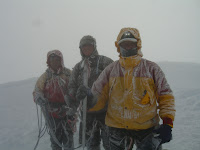
 You can see the crater of the volcano from the top, although the weather got a little nasty and visibility was very limited. I managed to grab just a couple pictures (really hard to do on top of the mountain - they´re pretty bad, I know), although I should be getting a few more from the Aussies soon.
You can see the crater of the volcano from the top, although the weather got a little nasty and visibility was very limited. I managed to grab just a couple pictures (really hard to do on top of the mountain - they´re pretty bad, I know), although I should be getting a few more from the Aussies soon.
We got back to the refuge around 11:30 AM and headed back to Quito. In hindsight, the rash, last-minute decision to make a repeat visit to the mountain while I was hungover was an incredibly good one, making me question why I ever bother planning anything.
I´m back in Quito this week until my passport comes through, taking classes and suffering through a few more salsa lessons. Also, the Quiteña whose phone number I lost with my backpack emailed me yesterday (I scribbled my email address on a napkin that I gave her friend 2 weeks ago that somehow resurfaced). Score one for the good guys!
VARIOS LIBROS EN ESPAÑOL
LIBROS DE TURISMO DE ECUADOR
MI PASAPORTE ORIGINAL DE LOS ESTADOS UNIDOS
DOS TARJETAS DE CREDITO UNA VISA Y UNA AMERICAN EXPRESS
DINERO EFECTIVO 250 DOLARES
VARIOS CUADERNOS CON APUNTOS PERSONALES
Y OTROS BIENES PERSONALES
A seriously bad night. I was left with 11 dollars to my name and zero personal identification (in my brilliance that day I kept my passport in the same place where I kept multiple laminated copies of my passport and credit cards....my backpack). The only shining light was that immediately beforehand I had taken my camera to a repair shop, so it survived the theft. I cancelled my credit cards, got intimate with the U.S. Embassy in Quito, had some ¨glamour head shots¨ taken at a photography place for my passport picture, and wrestled with the powers that be at Western Union to permit a transfer of cash from the U.S. with only a photocopy of an application for a new passport and the accompanying police report to call personal identification. My new passport should be here by next Monday.
The moral of the story is that I´m an idiot. Quito is pretty safe but petty theivery is rampant all over. I was lazy and careless, and absolutely should have at least had the strap of the backpack wrapped around my leg (the strap of the new $7 replacement bag I bought is wrapped around my leg right now. Two of its zippers already broke, so there´s no way I´m going to look like a rich tourist sporting it). Additionally, I had stuffed my money belt (which is supposed to go around your waist under your clothes) in my backpack, defeating the purpose of its design. I kind of deserved it.
So that would have been my weekend, and I would have wallowed around Quito thinking about the stuff I lost (which included the phone number of a Quiteña girl I´ve gotten to know down here - the only way I had to contact her). But no. Friday night I went out to a popular gringo bar called Bungalo 6, getting home around 3 AM. Saturday morning I woke up at 7:30 AM, totally disoriented until I remembered why I had set my alarm the night before. Friday afternoon I learned that Saturday night would bring a full moon to Ecuador. Prime time for a midnight stroll!
To backtrack a bit, last weekend I made an ill-fated voyage to Cotopaxi National Park to scale the South face of Cotopaxi, a snow-capped volcano (height: 5,897 meters aka. 19,342 feet). During my 3-day, 2-night stay the weather changed from bad to awful, and during the afternoon that we (me, an indigenous guide and a 40-something semi-professional swiss alpinist woman) hiked from our refuge (4200 meters) to a set of permanent tents (4900 meters) designed as a rest stop before the climb to the summit (5897 meters), the mountain gods were not having it. The wind and snow made visibility almost zero, and the soft snow on the ground made for waist-deep hiking and possible avalanches. We opted out. I was a little bitter.
So back to the full moon. Saturday morning I woke up a stupor and decided on the spot that if a travel agency would take me in my condition (and hadn´t left for the mountain yet), it was a sign that a repeat effort was meant to be, even if it blew a big portion of the precious cash that was Western Unioned from the States. I checked out of my hostal and galloped to the gringo district of Quito with all my personal belongings (sans passport). I spotted people putting snow gear into a truck in front of a travel agency, and sure enough they were heading for Cotopaxi with 2 Australian tourists. I talked the jefe (boss) down to a pretty deep discount on the normal excursion price, and before I knew it I was on my way back to Cotopaxi, this time to attempt the much more heavily travelled north face with the Aussies and a guide.
At 1:00 I was fully outfitted in ice climbing gear (ice axe, rope and crampons) and we were off to climb Cotopaxi. That night, I am told some 40 people attempted the climb to the top. Me, the Aussies and our guide were among the 10 that made it to the top. It was not easy.
As this was my first climbing experience the only thing I can compare it to is looking out the window of an airplane. To complete the imagery, though, the airplane´s fuselage would be made of incredible ice formations and it would also be cruising with the windows rolled down -- it was that windy.
We reached the summit at 8 PM, a dangerously late time to be bojangling on the top of this volcano as that´s when the ice starts to melt and the ground becomes unstable.
We got back to the refuge around 11:30 AM and headed back to Quito. In hindsight, the rash, last-minute decision to make a repeat visit to the mountain while I was hungover was an incredibly good one, making me question why I ever bother planning anything.
I´m back in Quito this week until my passport comes through, taking classes and suffering through a few more salsa lessons. Also, the Quiteña whose phone number I lost with my backpack emailed me yesterday (I scribbled my email address on a napkin that I gave her friend 2 weeks ago that somehow resurfaced). Score one for the good guys!
Subscribe to:
Posts (Atom)